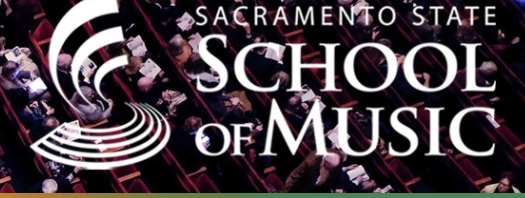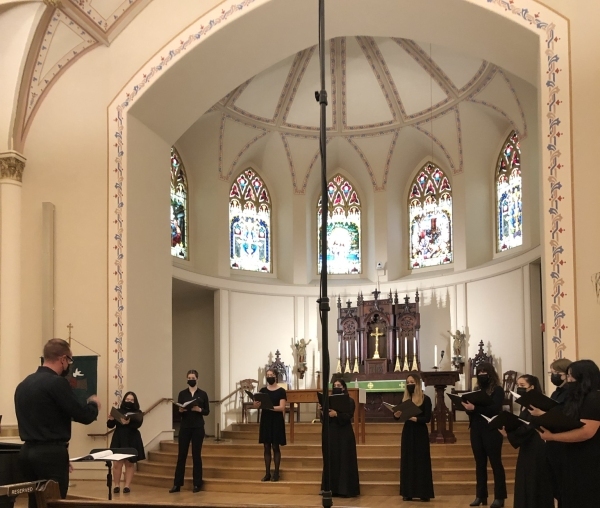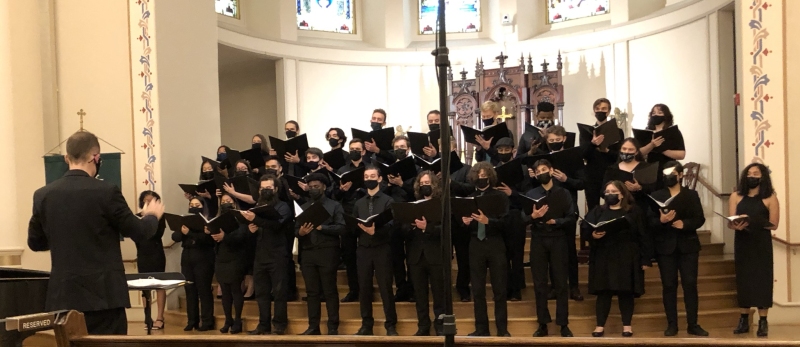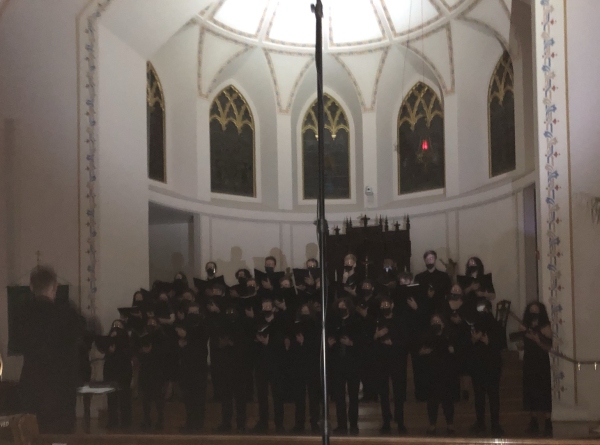Choral Review
Sacramento State University, School of Music
University Singers and Choral Union
I needed this. I dare say everyone in the audience needed this. It was one of the first live, indoor choral concerts of the pandemic era ─ certainly the first for me. The media’s weather reports had told us we were getting a “bomb cyclone” and an “atmospheric river.” It didn’t matter. Not to those of us who had been deprived of live choral music for so long. So we braved the weather and accepted the requirement to wear masks. In the end, it was a small price to pay.
St. John’s has been so widely used for choral concerts over the
years, with its excellent acoustics, that it’s no wonder this would be
the venue for this first live choral concert for me and so many others.
On the left and right, above our heads, where the balconies jutted out
into the sanctuary, were written in large gold letters these words:
“Surrender to grace.” The sentiment seemed as appropriate for a choral
concert as for a religious service.

The concert was to feature two Sacramento State choruses: the University Singers and the Choral Union. Looking over the program, I noticed that four of the five pieces to be performed by the University Singers were from living composers. The five Choral Union selections seemed to represent more diverse eras. (Click here to open the concert program in a new window.)
University Singers
The University Singers were to begin the program, and a few minutes after the announced start time of the concert, these twelve women filed in ─ dressed in diverse all-black outfits ─ and formed into a semicircle below the steps of the altar. They were directed by Dr. Andrew Kreckmann, Asst. Professor and Director of Choirs at Sac State. Kreckmann greeted us and spoke briefly about the choral program at the university before giving some background on each of the five selections to come, sometimes reading the lyrics, and even noting that he had discussed with a couple of the composers how to present their music.
 As
Kreckmann spoke, I realized that this was more than a concert; it was a
learning opportunity that an academic wouldn’t want to let slip away.
Accordingly, Kreckmann’s introduction to each piece was extensive,
as he undertook to help the audience appreciate better what the composer
was offering and what the singers would be trying to express.
As
Kreckmann spoke, I realized that this was more than a concert; it was a
learning opportunity that an academic wouldn’t want to let slip away.
Accordingly, Kreckmann’s introduction to each piece was extensive,
as he undertook to help the audience appreciate better what the composer
was offering and what the singers would be trying to express.
And while noting that this was a performance by an academic institution, let me point out that Sac State has outdone not just community choruses but all our area colleges and universities, by being the first with live, indoor concerts.
“Hope Lingers On” started with a bit of percussion, the women clapping and stomping in rhythm, some tapping their chests. When they began to sing, you’ll pardon me if I say it was music to my ears: well-tuned and balanced singing of a gentle song with very listenable harmonies, performed a cappella and from memory. The lyrics begin with “My mother, my sister, when love is gone, in our darkest hour, hope lingers on.” I wasn’t able to discern these words during the performance and only found them afterwards. However, Kreckmann had prepared us for the message and, as he explained, he didn’t want us to be distracted by consulting words printed in a program.
For the next piece, “Look Down, Fair Moon,” Kreckmann noted that it would be one of the selections for their concert that will close the upcoming Festival of New American Music (Nov. 7-14). In discussing the artistry of the composer, he made the point that she was emphasizing a dichotomy between real and idealized visions of the world, giving us “evocative” and “exotic imagery” in a beautiful score to accompany the “gruesome” text by Walt Whitman (from his Leaves of Grass). (Here is a link to that text.) That beautiful score was accentuated by a delicate piano accompaniment from the eminently accomplished Dr. Ryan Enright, with most of the singers swaying to its beat. Sadly, the articulation of their singing was inhibited somewhat by their masks, but they produced the same excellent tone they had achieved in the previous selection.
Kreckmann next explained that Vivaldi’s “Tecum Principium,” though intended for use in a high mass setting, was a bit iconoclastic, incorporating operatic elements, character (or a “story line”), as well as a bit of humor. We did our best listening to discern these elements as the choir accurately performed the baroque elements of this piece, so different from what had come before. The accompaniment, was very dense, giving Enright a workout that earned him a special round of appreciation from the audience after the singers had been acknowledged.
In preparation for “For the Beauty of the Earth,” Kreckmann read the original lyrics, going beyond what is typically in the hymns or anthems (e.g. by John Rutter) performed under this title. As the piece unfolded, the piano accompaniment was full of arpeggios, supporting the lovely harmonies produced by the chorus. The soloists delivered their brief parts in sweet tones, perhaps tinged with a bit of nervousness. The overall impression of the piece was such that, whether intended or not, it felt to me like a religious experience.
In preparation for the final piece of this first half of the concert, Kreckmann warned us of the irregular meter of “Shine on Me.” That might have caused some of the audience to be apprehensive of something hard to listen to. Instead, we got music that was consistently interesting and appealing, with many varied statements of the basic theme. The changes in meter required careful attention by the singers, and the brisk accompaniment required an exceptionally talented pianist ─ which we were fortunate to have in Enright.
This varied set of music was an excellent showcase for this chamber choir that had obviously worked hard to present polished music so early in the semester.
Choral Union
As the University Singers withdrew, the much larger Choral Union
entered ─ a mixed chorus of 33
singers. They were dressed in black and filled the stairs leading to the
altar. Their director, Dr. Brett Judson, introduced himself (and his
chorus) to us, and proceeded to give some background on the “Fengyang
Song,” which was to be sung in Mandarin. (Fortunately, the chorus had
one member who could serve as an experienced pronunciation coach.) For
Judson, a lecturer at Sac State, I believe this was his first outing to
direct a Sac State chorus in concert, though he has extensive experience
as a church organist and choirmaster.

I found the “Fengyang Song” an interesting way to begin a set of music. It demonstrated the versatility of the singers in their language pronunciation, and it was perhaps the first time many of us had heard a choral performance of Chinese music. Most importantly, I felt that the piece was delivered with a full, balanced sound, though I was immediately impressed with the strength of the bass section.
That rich choral sound persisted in the performance of di Lasso’s madrigal, “Matona, Mia Cara.” Judson introduced the piece by describing the situation portrayed (a serenade under a balcony by a would-be suitor), pointing out the humor in di Lasso’s mistakes in writing in Italian. As I listened, I wrote in my notes that I was hearing “the choral music I’ve been waiting for” ─ expressive, accurate singing from a disciplined and well-prepared mixed chorus.
For “The Road Home” I wrote the word “exquisite” in my notes. It was a comforting presentation in which the audience was embraced by both the music and the lyrics, as Judson brought out each nuance of thought and feeling, demonstrating the composer’s intention of “significant simplicity.” Soprano Kaitlyn Roberts gave a beautiful performance, with her pure sound floating about the chorus. To me, this piece seemed like the culmination of the concert to this point. And at the music’s conclusion, the audience was especially appreciative.
 Judson
explained “Zion’s Walls” as a Southern revival song based on shape note
singing, and he warned us that it is a song of “great enthusiasm and
excitement.” Indeed it was, quite in contrast to the preceding
selection, “The Road Home.” And while the first three songs had been
performed a cappella, this one had Enright again at the piano. It was
certainly exciting music, and the excitement was peaking when the lights
in the church went out. There were a few moments of silence
─ and then Judson led the chorus to
conclude the song. Everyone loves to see adversity overcome
─ almost as much as they love
overcoming adversity themselves. So when the Choral Union finished the
song, there was an explosion of cheers and applause.
Judson
explained “Zion’s Walls” as a Southern revival song based on shape note
singing, and he warned us that it is a song of “great enthusiasm and
excitement.” Indeed it was, quite in contrast to the preceding
selection, “The Road Home.” And while the first three songs had been
performed a cappella, this one had Enright again at the piano. It was
certainly exciting music, and the excitement was peaking when the lights
in the church went out. There were a few moments of silence
─ and then Judson led the chorus to
conclude the song. Everyone loves to see adversity overcome
─ almost as much as they love
overcoming adversity themselves. So when the Choral Union finished the
song, there was an explosion of cheers and applause.
Resolved to complete the concert, many (including Judson) brought out their smartphones for light. By this light, Judson read his introduction, quoting lyricist Jane Griner: “There are times in our lives when nothing but music can express the intensity of what we’re feeling.” That was the initial part of a Judson’s closing statement, and it epitomizes the effect that choral music ─ including all of this afternoon’s music ─ has as we “surrender to grace.”
When the Choral Union proceeded to perform “Sing Me to Heaven,” the smartphone light proved unnecessary. Someone had found a spotlight to shine on the dome above the singers, giving them enough light from which to read their scores. The beautiful tone I’d observed at the start was again especially apparent as the women sang alone, to be followed by the men before all the parts sang together. I couldn’t make out many of the words, but I could tell that they reinforced the comfort of the music. (Click here for the inspiring, thought-provoking lyrics to “Sing Me to Heaven.”)
When the song ended, applause and cheers filled he darkened church. On this rainy afternoon, we had indeed been “sung to heaven.”
Dick Frantzreb is editor of the Capital Region Performance Gallery. He also edits the Sacramento Choral Calendar and the Placer Performance Calendar, and he was a co-founder and past President of the Sacramento Valley Choral Coalition. He has been loving live performances in the greater Sacramento area and writing about them since 2012.